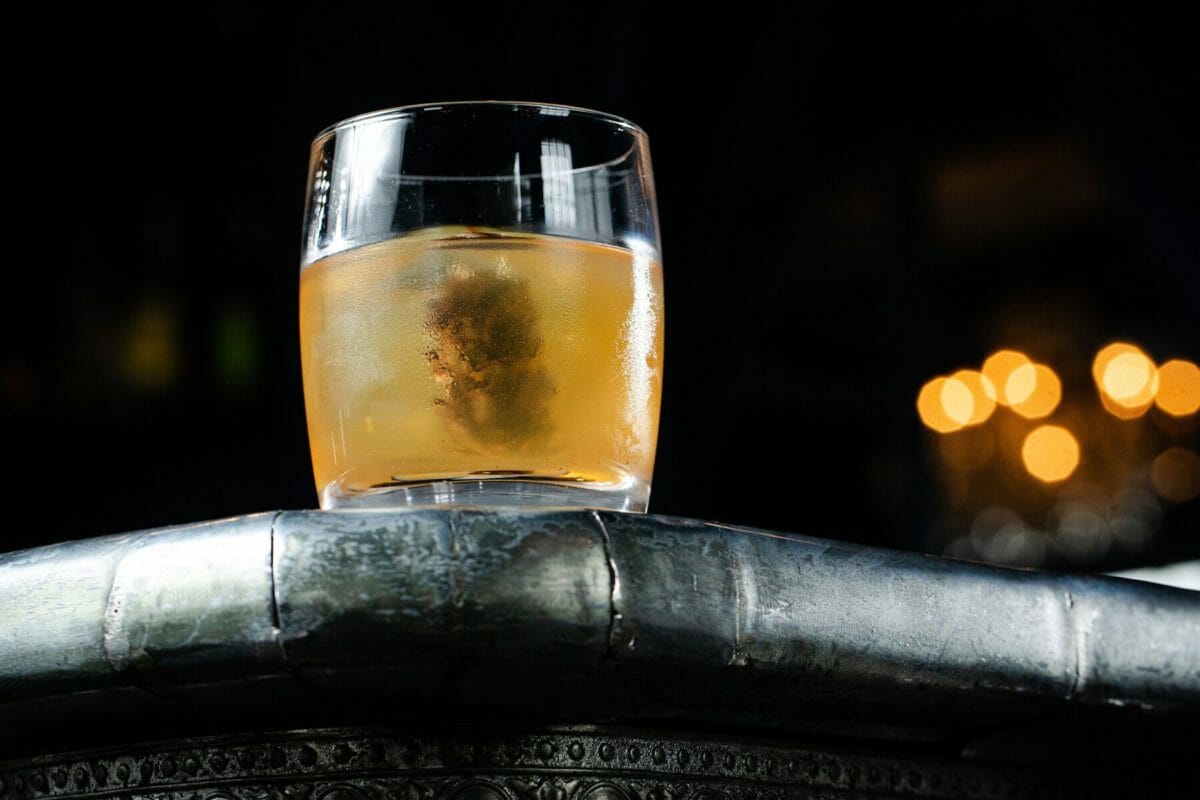Turning Pine Cones Into Cocktails
How a mixologist and Maryland farmer are combining forces to make unique libations.
Turning Pine Cones Into Cocktails
How a mixologist and Maryland farmer are combining forces to make unique libations.

The Bluebird Cocktail Room in Baltimore is using pine cone syrup, harvested by a local farmer, for its new gin cocktail, the blacksmith. by Justin Tsucalas
When Jon Shaw started to focus on selling his produce to restaurants, he realized that many establishments wanted to buy from local farms but simply couldn’t get the vegetables they needed from them in winter months.
So the Maryland farmer started investing in season extension infrastructure, building hoop houses, a large heated greenhouse and a hydroponic unit. This gave his farm—Karma Farm—the ability to sell fresh produce throughout the year. He also started experimenting with different crops in varying environments, leading him to grow “some pretty unusual items” for the area and time of year.
This experimentation caught the attention of Paul Benkert, owner of Baltimore’s Bluebird Cocktail Room, who is constantly on the lookout for new ingredients to infuse into his drinks.
“Sometimes things work and sometimes things don’t, but we always try something to see if we can get a good flavor out of it,” Benkert says. “For bartenders, everyone’s trying to take an obscure ingredient and almost force it into a drink. I’m very aware that a lot of times they don’t taste very good.”

Shaw and Benkert now share a symbiotic relationship, in which the farmer supplies some of the mixologist’s unusual requests for his botanically influenced menu.
One of those requests was for fresh, unripened pine cones. Benkert wanted to use the sap in pine cones to make a syrup for a new gin cocktail. He says this type of syrup is much deeper in flavor than a maple syrup and is traditional in Scandinavian countries.
Shaw had trees with pine cones on his farm, but he had no idea how to get them down. One day this summer, a strong wind storm solved that problem, bringing down a large pine tree on the edge of Shaw’s property.
The farmer and his wife were able to scrounge 40 to 50 pounds of pine cones for Benkert, who is using them in drinks this fall and winter. Benkert says that it was a win for both of them, as he got a good product out of it and the farmer got a bit of added income.
Benkert says people are generally curious about where their food comes from, but they don’t ask the same of their drinks. He has hundreds of bottles of liquor on his shelves, and yet customers rarely ask what vegetable or plant went into a certain drink, or where the sugar came from that went into them. He hopes his cocktails will push people to start asking those questions.
As for Shaw, he enjoys the challenge that often comes with Benkert’s requests.
“It gets a little boring just growing two thousand pounds of potatoes,” he says.

Below is a recipe for the pine cone syrup and one of the bar’s cocktails that incorporates it.
Pine cone syrup recipe:
(1) Fill a pot with harvested green pine cones
(2) Cover pine cones completely with water
(3) Bring to a boil, then turn off heat and let steep for 30 minutes, or up to 24 hours in the refrigerator for stronger flavor. (Watch out, it gets bitter quickly.)
(4) Strain liquid from cones
(5) Pour liquid into pot with turbinado sugar (2:1 ratio pine water to sugar)
(6) Reduce by half on medium heat, refrigerate up to a month
Note: For a more intense flavor and longer shelf life, reduce by 85 percent just before caramelization.
Blacksmith
Barr Hill Tom Cat Gin (juniperus), Pine cone syrup (pinus lambertiana)
2.0 oz Barr Hill Tom Cat Gin
.50 oz pine cone syrup
Served in a double rocks glass
Follow us
This work is licensed under a Creative Commons Attribution-NoDerivatives 4.0 International License.
Want to republish a Modern Farmer story?
We are happy for Modern Farmer stories to be shared, and encourage you to republish our articles for your audience. When doing so, we ask that you follow these guidelines:
Please credit us and our writers
For the author byline, please use “Author Name, Modern Farmer.” At the top of our stories, if on the web, please include this text and link: “This story was originally published by Modern Farmer.”
Please make sure to include a link back to either our home page or the article URL.
At the bottom of the story, please include the following text:
“Modern Farmer is a nonprofit initiative dedicated to raising awareness and catalyzing action at the intersection of food, agriculture, and society. Read more at <link>Modern Farmer</link>.”
Use our widget
We’d like to be able to track our stories, so we ask that if you republish our content, you do so using our widget (located on the left hand side of the article). The HTML code has a built-in tracker that tells us the data and domain where the story was published, as well as view counts.
Check the image requirements
It’s your responsibility to confirm you're licensed to republish images in our articles. Some images, such as those from commercial providers, don't allow their images to be republished without permission or payment. Copyright terms are generally listed in the image caption and attribution. You are welcome to omit our images or substitute with your own. Charts and interactive graphics follow the same rules.
Don’t change too much. Or, ask us first.
Articles must be republished in their entirety. It’s okay to change references to time (“today” to “yesterday”) or location (“Iowa City, IA” to “here”). But please keep everything else the same.
If you feel strongly that a more material edit needs to be made, get in touch with us at [email protected]. We’re happy to discuss it with the original author, but we must have prior approval for changes before publication.
Special cases
Extracts. You may run the first few lines or paragraphs of the article and then say: “Read the full article at Modern Farmer” with a link back to the original article.
Quotes. You may quote authors provided you include a link back to the article URL.
Translations. These require writer approval. To inquire about translation of a Modern Farmer article, contact us at [email protected]
Signed consent / copyright release forms. These are not required, provided you are following these guidelines.
Print. Articles can be republished in print under these same rules, with the exception that you do not need to include the links.
Tag us
When sharing the story on social media, please tag us using the following: - Twitter (@ModFarm) - Facebook (@ModernFarmerMedia) - Instagram (@modfarm)
Use our content respectfully
Modern Farmer is a nonprofit and as such we share our content for free and in good faith in order to reach new audiences. Respectfully,
No selling ads against our stories. It’s okay to put our stories on pages with ads.
Don’t republish our material wholesale, or automatically; you need to select stories to be republished individually.
You have no rights to sell, license, syndicate, or otherwise represent yourself as the authorized owner of our material to any third parties. This means that you cannot actively publish or submit our work for syndication to third party platforms or apps like Apple News or Google News. We understand that publishers cannot fully control when certain third parties automatically summarize or crawl content from publishers’ own sites.
Keep in touch
We want to hear from you if you love Modern Farmer content, have a collaboration idea, or anything else to share. As a nonprofit outlet, we work in service of our community and are always open to comments, feedback, and ideas. Contact us at [email protected].by Alex Robinson, Modern Farmer
October 17, 2019
Modern Farmer Weekly
Solutions Hub
Innovations, ideas and inspiration. Actionable solutions for a resilient food system.
ExploreExplore other topics
Share With Us
We want to hear from Modern Farmer readers who have thoughtful commentary, actionable solutions, or helpful ideas to share.
SubmitNecessary cookies are absolutely essential for the website to function properly. This category only includes cookies that ensures basic functionalities and security features of the website. These cookies do not store any personal information.
Any cookies that may not be particularly necessary for the website to function and are used specifically to collect user personal data via analytics, ads, other embedded contents are termed as non-necessary cookies.
what kind of pine cones are these? Maybe Hemlock? small cones?